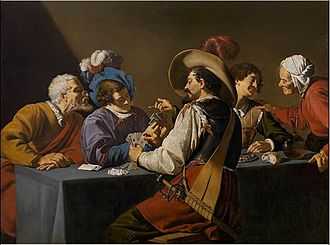Theodoor Rombouts

Theodoor Rombouts (2 July 1597 – 14 September 1637) was a Flemish painter who created Caravaggesque genre scenes depicting lively dramatic gatherings and religiously themed works.[1]
Life
Rombouts was born and died in Antwerp. He studied under Abraham Janssens and Nicolas Régnier in Antwerp. He traveled to Rome in 1616 and stayed there until 1625. It is possible that in Florence he met the Caravaggist Bartolomeo Manfredi and worked for Cosimo II de' Medici.[2]
When he got back he became a member of the Guild of St. Luke and in 1627 he married Anna van Thielen, the sister of Jan Philip van Thielen, who became his pupil in 1631.[3] From 1628-1630 he was deacon of the Guild in Antwerp. In 1635 Rombouts collaborated with other artists on the decorations of the Joyous Entry of Cardinal-infante Ferdinand in Antwerp, which was under the general direction of Rubens. He died not long after the completion of this decorative programme.[2]
Rombouts' pupils were Nicolaas van Eyck, Jan Philip van Thielen and Paulus Robyns.[3]
Work

He painted mainly profane works depicting merry companies, musicians, card players, as well as some of the other Caraveggesque themes such as the denial of St Peter.[1] He worked on commission and on the free market. Many of his commissions came from Ghent. His monumental genre pieces were painted on horizontal canvases. He also painted a few religious and mythological works in landscape format, such as Christ Driving the Money-changers from the Temple (Royal Museum of Fine Arts Antwerp).[2]
His initial works were in the idiom of his master Abraham Janssens. This is clear in the early composition Cephalus and Procris (Hermitage Museum, 1610s) which in its three-dimensionality and use of Classical forms is clearly indebted to Janssens.[4] He was the most successful after his return from Italy during the heyday of the Caravaggio movement in the Southern Netherlands from 1620 to 1640. His Caravaggesque conversation pieces are realistic and expressive. His work during this period is characterised by the use of chiaroscuro, the horizontal format and a pronounced modelé that sometimes looks sculptural and that points to the influence of his master Abraham Janssens. His use of diagonals in the composition and perspectival abbreviation is prominent in a work such as the Card players (Royal Museum of Fine Arts Antwerp).[2]
The popularity of the Caravaggio movement lost steam after 1630. Rombouts abandoned chiaroscuro effects for more tempered lighting, smoother transitions and a lighter palette. A good example of this is The Mystical Marriage of Saint Catherina (Saint James's Church, Antwerp). This late style approaches the later work of Rubens, with whom he collaborated in the realization of the decorations for the Joyous Entry of Cardinal-Infante Ferdinand in Antwerp in 1635.[4]
References

- ↑ 1.0 1.1 Hans Vlieghe, "Rombouts, Theodoor," Grove Art Online. Oxford University Press, [accessed 6 January 2008].
- ↑ 2.0 2.1 2.2 2.3 Matthias Depoorter, Theodoor Rombouts at Baroque in the Southern Netherlands
- ↑ 3.0 3.1 Theodoor Rombouts at the Netherlands Institute for Art History (Dutch)
- ↑ 4.0 4.1 Theodoor Rombouts at the Prado Museum encyclopedia (Spanish)
External links
- A Caravaggio Rediscovered, The Lute Player, an exhibition catalog from The Metropolitan Museum of Art (fully available online as PDF), which contains material on Rombouts (see cat. no. 16)
| Wikimedia Commons has media related to Theodoor Rombouts. |
| ||||||||||||||||||||||||||||||||||
|